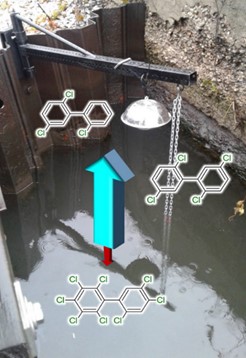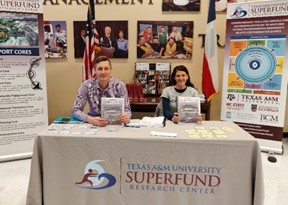Hot Off the Press
The Superfund Research Program (SRP) regularly highlights basic and applied research and activities from the program that span multiple disciplines.
Research Briefs

Passive Samplers Tackle PCB Flux
Researchers from the University of Iowa SRP Center have developed a method to measure the movement, or flux, of polychlorinated biphenyls (PCBs) from water to air using air and water passive sampling devices. Measuring the flux of PCBs is important for understanding their movement from the dissolved phase in water to a gaseous phase in the air, but this has been a challenge with traditional approaches. The team demonstrated that simple and cost-effective passive samplers could be used to overcome this challenge.
Promising Membrane Technology Reduces Chlorobenzene in Groundwater
A new SRP collaboration has developed a promising groundwater cleanup technology that provides an efficient, low-maintenance method of removing chlorobenzene and other compounds from water. The method integrates electrochemical oxidation, which uses electricity to transform contaminants into non-toxic substances, and membranes containing palladium, a metal used as a catalyst in many industrial chemical synthesis applications and groundwater treatment.
Study Sheds Light on Respiratory Toxicity of EPFRs
A new SRP study explains how particulate matter (PM) containing environmentally persistent free radicals (EPFRs) activates the aryl hydrocarbon receptor (AhR). AhR is known to play an important role in detecting and responding to a variety of pollutants. These findings could prove useful in understanding the underlying mechanism of diseases known to be associated with inhalation of PM, such as cardiovascular disease.
NIEHS Environmental Factor Articles

Texas Workshop Prepares Trainees for Disaster Research
The Texas A&M University SRP Center hosted a first-of-its-kind Disaster Research Training Workshop focused on conducting environmental health-related research in complex disaster-related situations. Trainees from Texas A&M University and 10 other academic centers around the country learned practical skills to inform research in the aftermath of an extreme weather event or other environmental emergency.
Greenness May Promote Heart Health
Living in green neighborhoods could reduce the risk of cardiovascular disease in susceptible individuals by decreasing the body's stress and boosting its ability to repair blood vessels, according to new research funded by NIEHS. Senior study author Aruni Bhatnagar, Ph.D., leads the University of Louisville SRP Center's Research Translation Core.

Paper of the Month: New Houseplant Enhances Cleanup of Air in Homes
Previously funded University of Washington SRP Center scientists developed a houseplant that can remove chloroform and benzene from the surrounding air. Benzene in the home can originate from outside air, fuel storage in attached garages, and tobacco smoke. Chloroform can be released into the air in small amounts from water during showering.
Multi-Disciplinary, Early Career Innovation Highlighted at SRP Meeting
The annual SRP meeting, held November 28 - 30 in Sacramento, California, emphasized innovative research to promote environmental health, particularly research driven by early-stage investigators and trainees.
Register Now: Progress in Research Webinars
This webinar series will feature individual research projects funded by the SRP. In 2013, the SRP initiated a targeted research program to better understand how contaminants in the environment are affected by complex biological, geological, and chemical processes. By understanding these complex interactions, we are better equipped to optimize remediation strategies and, therefore, improve science-based decision making for site management, priority setting, and remedy selection. The individual research project grants support problem-solving research on the mechanisms of biogeochemical interactions that may impact remediation of contaminated soil, sediment, surface water, or groundwater.
-
April 22, 1:00 - 3:00 p.m. EDT: Session I - Johns Hopkins University, University of Tennessee
-
May 13, 1:00 - 3:00 p.m. EDT: Session II - Colorado School of Mines, University of California - Riverside, Virginia Institute of Marine Science
-
May 20, 1:00 - 3:00 p.m. EDT: Session III - Duke University, University of California - Berkeley, University of Maryland - Baltimore County
More information is also available on the SRP Progress in Research website.
to Top



